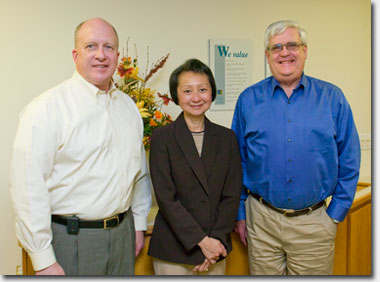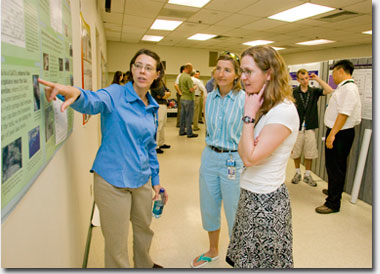News Briefs: May 16, 2008
NNSA nuclear safety official visits the Lab
Gerald Talbot, assistant deputy administrator for Nuclear Safety and Operations at the National Nuclear Security Administration, met with Laboratory, Livermore Site Office and Sandia employees earlier this week for briefings and tours.
At the Livermore Site Office, Talbot listened to overviews on maintenance and operations, contract issues, performance evaluation plans and other issues.
While at the Laboratory, Talbot toured the Superblock, the Radioactive Materials Area and Site 300.
Talbot is responsible for site operations, facilities management and nuclear and non-nuclear safety for the NNSA nuclear weapons complex. Before assuming this position, he was the manager for the NNSA Nevada Site Office. As manager he was responsible for operation and maintenance, including other facilities and sites, to implement NNSA initiatives in stockpile stewardship and management, nuclear test readiness, crisis management, nonproliferation, environmental management and stewardship, alternate energy, and other science and technology development.
Before his stint as the Nevada Site Office manager, Talbot served 35 years in the U.S. Navy.
Kathy Shingleton selected as Health Physics Society Fellow
Kathy Shingleton, of the Hazards Control Radiation Safety Program, has been selected as a fellow in the Health Physics Society (HPS). The award honors senior members of the society who have made significant administrative, educational, and/or scientific contributions to health physics (radiation safety).
In receiving this award, Shingleton joins other distinguished LLNL health physicists including Lynn Anspaugh, Thomas Crites, Dale Hankins, David Myers, Wade Patterson, Bryce Rich and Ralph Thomas.
Shingleton said she was honored by the distinction. "Throughout my career, I’ve viewed the HPS Fellows as pillars of the health physics society; they are the ones who created the foundations of our profession," she explained. "So it is quite humbling to be included with such an august group of people. "
Shingleton began her career at the Lab in 1979. She has provided health physics support to many of the Lab’s major facilities and programs, including the Plutonium Facility, Chemistry, Physics, and the Marshall Islands Program. She also has provided institutional radiation safety program support for six years as the Radiation Safety section leader and another six years as the Health Physics technical leader. She has participated throughout her career in the Department of Energy’s Accident Response Group (ARG) and Radiological Assistance Program (RAP).
Shingleton has been active in the local and national Health Physics Society, the American Academy of Health Physics (AAHP) and the American Board of Health Physics (ABHP). She has served as the president of the Northern California Chapter of the HPS, as secretary for the AAHP, and is on the HPS Board of Directors. She served on the ABHP Exam Panel for 10 years and is a sub-committee member of the National Council on Radiation Protection.
Shingleton has a bachelor’s degree in biology and health physics from Virginia Polytechnic Institute and State University, and a master’s degree in health physics. She also is certified by the American Academy of Health Physics.
Institutional postdoc poster symposium draws a crowd
Postdocs from throughout the Lab showed off their research Thursday during the first LLNL postdoctoral poster symposium in the former Central Café.
More than 100 postdocs discussed their research with other Laboratory employees. Subjects ranged from biodefense to water quality to tuberculosis detection technology to hydrogen-powered vehicles.
See the video below to watch interviews with a few of the postdocs attending the symposium.







